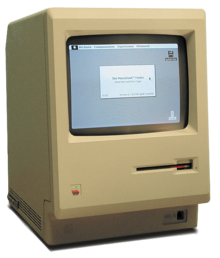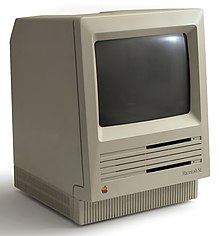
The Apple IIe Card is a compatibility card, which through hardware and software emulation, allows certain Macintosh computers to run software designed for the Apple II series of computers. Released in March 1991 for use with the LC family, Apple targeted the card at its widely dominated educational market to ease the transition from Apple II-based classrooms, with thousands of entrenched educational software titles, to Macintosh-based classrooms.

The Macintosh Plus computer is the third model in the Macintosh line, introduced on January 16, 1986, two years after the original Macintosh and a little more than a year after the Macintosh 512K, with a price tag of US$2,599. As an evolutionary improvement over the 512K, it shipped with 1 MB of RAM standard, expandable to 4 MB, and an external SCSI peripheral bus, among smaller improvements. Originally, the computer's case was the same beige color as the original Macintosh, Pantone 453; however, in 1987, the case color was changed to the long-lived, warm gray "Platinum" color. It is the earliest Macintosh model able to run System Software 5, System 6, and System 7, up to System 7.5.5, but not System 7.5.2.

The Macintosh Classic is a personal computer designed, manufactured and sold by Apple Computer from October 1990 to September 1992. It was the first Macintosh to sell for less than US$1,000.

The Macintosh II is a personal computer designed, manufactured, and sold by Apple Computer from March 1987 to January 1990. Based on the Motorola 68020 32-bit CPU, it is the first Macintosh supporting color graphics. When introduced, a basic system with monitor and 20 MB hard drive cost US$5,498. With a 13-inch color monitor and 8-bit display card the price was around US$7,145. This placed it in competition with workstations from Silicon Graphics, Sun Microsystems, and Hewlett-Packard.

The Macintosh SE/30 is a personal computer designed, manufactured and sold by Apple Computer from January 1989 to October 1991. It is the fastest of the original black-and-white compact Macintosh series.

The Macintosh IIci is a personal computer designed, manufactured, and sold by Apple Computer, Inc. from September 1989 to February 1993. It is a more powerful version of the Macintosh IIcx, released earlier that year, and shares the same compact case design. With three NuBus expansion slots and a Processor Direct Slot, the IIci also improved upon the IIcx's 16 MHz Motorola 68030 CPU and 68882 FPU, replacing them with 25 MHz versions of these chips.

The Macintosh II is a family of personal computers that was designed, manufactured and sold by Apple Computer, Inc. from 1987 to 1993. The Macintosh II was the initial model, representing the high-end of the Macintosh line for the time. Over the course of the next six years, seven more models were produced, culminating with the short-lived Macintosh IIvi and Macintosh IIvx models. Apple retired the Macintosh II name when it moved to Motorola 68040 processors; the Centris and Quadra names were used instead.

The Macintosh LC is a family of personal computers designed, manufactured and sold by Apple Computer, Inc. from 1990 to 1997.
Apple Inc. has sold a variety of LCD and CRT computer displays. Apple paused production of their own standalone displays in 2016 and partnered with LG to design displays for Macs. In June 2019, the Pro Display XDR was introduced, however it was expensive and targeted for professionals. Nearly three years later, in March 2022, the Studio Display was launched as a consumer-targeted counterpart to the professional monitor. These two are currently the only Apple-branded displays available.

The Macintosh Color Classic is a personal computer designed, manufactured and sold by Apple Computer, Inc. from February 1993 to May 1995. It has an all-in-one design, with a small, integrated 10″ Sony Trinitron display at 512 × 384 pixel resolution. The display is capable of supporting up to thousands of colors with a video memory upgrade.

The Apple Macintosh—later rebranded as the Macintosh 128K—is the original Apple Macintosh personal computer. The Macintosh was the first successful mass-market all-in-one desktop personal computer with a graphical user interface, built-in screen, and mouse. It played a pivotal role in establishing desktop publishing as a general office function. The motherboard, a 9 in (23 cm) CRT monitor, and a floppy drive were housed in a beige case with integrated carrying handle; it came with a keyboard and single-button mouse. It sold for US$2,495. The Macintosh was introduced by a television commercial entitled "1984" shown during Super Bowl XVIII on January 22, 1984 and directed by Ridley Scott. Sales of the Macintosh were strong at its initial release on January 24, 1984, and reached 70,000 units on May 3, 1984. Upon the release of its successor, the Macintosh 512K, it was rebranded as the Macintosh 128K. The computer's model number was M0001.

The Macintosh 512K is a personal computer that was designed, manufactured and sold by Apple Computer from September 1984 to April 1986. It is the first update to the original Macintosh 128K. It was virtually identical to the previous Macintosh, differing primarily in the amount of built-in random-access memory. The increased memory turned the Macintosh into a more business-capable computer and gained the ability to run more software. It is the earliest Macintosh model that can be used as an AppleShare server and, with a bridge Mac, communicate with modern devices.

The Macintosh IIcx is a personal computer designed, manufactured and sold by Apple Computer, Inc. from March 1989 to March 1991. Introduced six months after the Macintosh IIx, the IIcx resembles the IIx and provides the same performance, but is seven inches narrower, ten pounds lighter, and quieter due to a smaller internal fan. The relative compactness results in three NuBus slots being available, compared with six on the IIx.

A Macquarium is an aquarium made to sit within the shell of an Apple Macintosh computer. The term was coined by computer writer Andy Ihnatko as a joke but Macquariums have since been built both by Ihnatko himself and by others.

MacTerminal was the first telecommunications and terminal emulation application software program available for the classic Mac OS. MacTerminal enabled users to connect via modem or serial port to bulletin board systems and online services, and to other computers. MacTerminal was capable of emulating the DEC VT100 and other computer terminals.
Macintosh is a family of personal computers designed by Apple Inc..
The Macintosh LC 500 series is a series of personal computers that were a part of Apple Computer's Macintosh LC family of Macintosh computers, designed as a successor to the compact Macintosh family of computers for the mid-1990s mainstream education-market. The all-in-one desktop case is similar to the then recently introduced Macintosh Color Classic, but the LC 500 series is considerably larger and heavier due to its larger screen and a bulging midsection to house the larger electronics, including a 14" CRT display, CD-ROM drive, and stereo speakers.
The classic Macintosh startup sequence includes hardware tests which may trigger the startup chime, Happy Mac, Sad Mac, and Chimes of Death. On Macs running macOS Big Sur or later, the startup sound is enabled by default. However, it can be disabled by the user within System Preferences or System Settings.

The Macintosh LC is a personal computer designed, manufactured, and sold by Apple Computer, Inc. from October 1990 to March 1992.


















